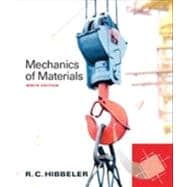Containing Hibbeler’s hallmark student-oriented features, this text is in four-color with a photorealistic art program designed to help students visualize difficult concepts. A clear, concise writing style and more examples than any other text further contribute to students’ ability to master the material.
This edition is available with MasteringEngineering, an innovative online program created to emulate the instructor’s office–hour environment, guiding students through engineering concepts from Mechanics of Materials with self-paced individualized coaching.
Note: If you are purchasing the standalone text or electronic version, MasteringEngineering does not come automatically packaged with the text. To purchase MasteringEngineering, please visit: masteringengineering.com or you can purchase a package of the physical text + MasteringEngineering by searching the Pearson Higher Education website. Mastering is not a self-paced technology and should only be purchased when required by an instructor.








